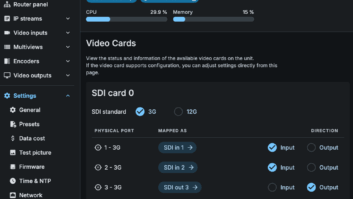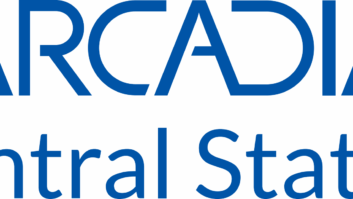In this edition of the Matrox Podcast, Sound & Video Contractor Magazine contributor Phil Hippensteel resumes his discussion with Matrox Business Development Manager, Ron Berty and Vice President of Research and Development for AV-over-IP Solutions, Dave Chiappini. They go into detail on compression and network latency, managing bandwidth and using V-LANs to separate network traffic.
Links of Interest
AV Over IP: A Revolution in Perspective – Podcast Part 1
AV Over IP: A Revolution in Perspective – Podcast Part 3
Download Podcast Here:
https://s3.amazonaws.com/nb-svc/public/public/Matrox_Podcast_Part_2_0.mp3
Well, welcome again to our audience to the second podcast in our series on AV over IP sponsored by Matrox, a partner to Sound and Video Contractor. My name is Phil Hippensteel and I am a contributor to Sound and Video Contractor. With me again are Ron Berty, Business Development Manager at Matrox and Dave Chiappini, who is the Vice President of Research and Development for AV-over-IP Solutions. In our first session, we discussed the paradigm of AV over IP, the importance of the H.264 standard to that paradigm and the distinction between Mpeg compression and the Mpeg transport stream format. We have a series of new questions for today and we’ll get right to them.
What about latency? And I’m referring both to compression latency and network latency. What’s your philosophy and is compression really a dirty word? How about the issue of latency and compression? Can you talk about that a little bit?
Ron: Yeah, sure. This is Ron again. In our view, I mean compression latency because the two kind of go hand-in-hand to a degree anyway, and varying degrees – it’s really application-specific in our view. So is there a problem with latency when the application to distribute the general AV sources is to iPads for like video-on-demand? Really in most cases that’s not the case, right? You’re just trying to watch a movie or watch Netflix and latency there doesn’t make any difference. And in the end for traditional AV there’s no way to do this at all. So latency really doesn’t apply at all in that case. It doesn’t matter. But at the same time are there applications where latency is mission critical? Absolutely. For sure there are. You know, imagine live concerts and, you know, there’s a pop star up on the stage and cameras are aimed at her. The video is now put up on the big Jumbotron behind her. In that case latency is imperative. Zero latency, or at least very, very near zero, is very important because that lip sync of the audio and her lips moving on that big screen have to be in perfect sync. So that’s a really important place that latency make a difference. And while there certainly are, you know, in many cases that’s done with traditional AV, but at the same time there are potential appliances or devices that can do this with a compression method too so that those types of devices are focused and concentrated on reducing latency. So what percentage of AV installations have the source and destination co-located in the same room? Well, you know, I guess that’s really depending on the application itself. But I would say that most cases are probably not that sensitive to latency. But at the same time where they are it needs to be addressed. So you can kind of look at the applications and sort of say okay where does it make a difference and to what degree does it make a difference? So the example of the show, the rock concert, whatever, it makes a huge difference. But where does it make a difference where maybe one frame of latency at 16 milliseconds when you’re running at 30 hertz makes a difference or maybe even when you’re running 60 hertz and that’s a 32 millisecond latency? You know, maybe that’s acceptable even in those environments. And then okay, what percentage of AV applications can tolerate up to half a second or even one second of latency glass-to-glass? And you know, there are many applications that can tolerate that when you’re not in the same room, overflow rooms, even when you’re transmitting I don’t know, lecture capture and that capture is going out over the internet and it’s basically on demand or even being recorded. All of those things the latency becomes less important. It’s really when, typically when it’s live when it becomes most important or critical decisions are being made on the content that is on the destination side of your AV-over-IP transmission that timing starts becoming much more important. So compression has a latency frontier for sure at this time. It’s definitely true. But compression-based solutions also have the ability to cover a broad spectrum of applications. Like we’ve said it really depends on where it is. And in an increasing percentage of AV cases from various vendors, keep getting optimized for latency. So this is one of the things that we’re trying to do here at Matrox, that we’re trying to optimize for latency and we’ll see that in the coming year with more products where we optimize. Sure, it won’t be zero latency. But there are ways to increase and optimize that latency so it becomes less and less and more applicable to more and more AV applications.[Timestamp: 04:35]
Well, one of the sister terms – as an old IT guy one of the terms that seems to always end up being discussed at the same time you’re talking about latency in a network, you usually talk about latency, packet loss and bandwidth. Bandwidth management is a topic that a lot of people talk about and I think we’re going to see a lot more of that bandwidth management. And I think it will become more and more integral to commissioning a system. What are your thoughts on the issue of managing bandwidth?
Ron: I think the managing bandwidth question is key for sure. At the same time there’s progress on both sides. So managing it and how you manage it, there’s different ways to deal with that today, but at the same time bandwidth is growing. I would say it’s particularly true to manage bandwidth when exploring the growth of potential AV convergence applications with data and communications. But at the same time the market already accommodates all scenarios including dedicated AV-over-IP 10-gigabit networks which are capable of transmitting uncompressed HD or lightly compressed 4K. And that’s soon to be replaced by like 25-gigabit networks which can pretty much comfortably fit, well in fact does comfortably fit uncompressed 4K. Bandwidth management is directly linked to the number of streams supported, the cost, the distances, the number of devices supported and types of devices supported. So yes, bandwidth is a real end game for AV-over-IP and H.264 has like very low bandwidth and any device interoperability, it has a great interoperability story today as Dave was mentioning before. But better and better codecs will continue to emerge and wow the market with pristine, really nice video and decrease bandwidth, so at the same time that bandwidth is growing. So we’ll see how that plays out, but there’s no question that when bandwidth management is a key element for AV-over-IP and depending on the type of network or the networks – multiple networks that you may be running – there’s all kinds of different ways to manage that bandwidth and to manage the streams of AV-over-IP that you’re sending across it. And it’s really an intelligent man’s opportunity to do that the right way with the right networks and the right codecs and appliances, devices, to stream those channels across the network. [Timestamp: 07:02]
I think one of the lesson we learned from the evolution – revolution, if you want to call it that – of voice-over-IP that IT folks had to learn was to incorporate voice; the way to properly incorporate voice into their networks was to basically put the voice on a separate V-LAN. And I think that the AV industry is now kind of toying with whether or not video needs to be in a separate V-LAN, segregated from the rest of the network. Do you think that the idea of using a V-LAN is going to both give a feeling of comfort to the IT folks and at the same time kind of guarantee that bandwidth is there and available for the video regardless of whether it’s low bandwidth or high bandwidth? Is the idea of using a V-LAN an important concept?
Ron: I think definitely it is. It’s related to the last question for sure. I mean managing that bandwidth and, you know, maybe separating the video LAN or the AV outside of the data LAN, if you will. So having a video LAN or V-LAN and having a data – a local area network if often a way of dealing with this today. But at the same time I don’t think there’s any question that AV will cross that IT or data network line too. And to some degree it’s already been happening for some time now. If we take, for example, like I think you mentioned it, IP phones. You know, the old analog PBX is long gone and has been replaced by the network and voice-over-IP. And generally speaking that’s running on the standard data LAN these days. Additionally the use of things like WebEx or Go to Meeting and applications like that that mix live and interactive audio and video over IP as well as today’s IP-enabled video conferencing systems all show that mixed AV and IT is currently happening on the network. Both the LAN and over the Internet. So with the advance of networking and capacity of the network its branches and trunks all going an 10-gigabit and soon at 25-gigbit, there’s more room for AV and IT to live together on the same network and not interrupt each experience for the users on whatever they’re addressing whether it’s AV or just data. At the same time AV continues to grow in capacity and feature set. So we went from standard definition to full HD and obviously that implies a higher bandwidth that you’re sending AV over IT with. And then you move to what’s happening now which is the emergence of 4K and driving 4K across the network, and then in the future even driving 8K. So it’s demanding more and more bandwidth even if the network bandwidth is growing by leaps and bounds and heading to 25G and more like I mentioned before. So I really believe that we’ll see more and more mixed AV and IT networks, but there will also continue the sort of standard where you do have a separate V-LAN and that really depends on what it is, the video that you’re sending and the AV that you’re sending across the network. And you might end up with a certain limited video on the standard data network and then where you’re really pushing high-end or high-quality video maybe that goes to a V-LAN. So at the same time there’s some organizations who want to maintain a clear separation of AV and IT networks no matter what the content or capacity of the network. This is not only owing to the often-discussed topics of security and mission-critical nature of the enterprise network and the data and making sure that everybody gets their data quickly and efficiently and so on, but it’s also sometimes simple reasons that are keeping the different specialists involved without sort of subordinating one function or the other and maybe also to evolve the different networks and capabilities at different intervals or speeds. So maybe the data network is evolving at a different rate than the AV network so maybe that’s a reason to sort of keep them separated because okay, you can maintain your data network with adding 10 users relatively easy, but you can’t maintain your AV network by adding 10 streams of 1080p or even 4K uncompressed data without really updating that network. So there’s a lot of reasons to sort of keep them separate but at the same time there’s a lot of new technology that allows you to combine them and depending in the level of bandwidth that you’re consuming with the video that makes it possible to combine that AV and IT network together. [Timestamp: 11:38]
One of the things that I’ve noticed when I’ve talked to people as a guy that came over from the IT side to into the AV side when I go to tradeshows and talk to people about transporting video over IP networks, it seems to me that sometimes people forget that if I’ve got a gigabit switch that has 24 ports on it it’s not really capable of just one gigabit per second, it’s got 12 what we used to call conversation paths through the switch. And the switches today are always built to handle all 12 gigabits at the same time. So in a certain sense when you do that segregation with V-LAN’s, even though you have one physical network with one set of cabling and one set of switches, you can create three or four or five separate gigabit networks to handle various kinds of video and various kinds of data.
Ron: I don’t think there’s any doubt about that. You’re right. There’s – I mean I’m not necessarily sure that like the lower cost, lower – maybe lesser brand names I guess of switches may not have that back plane that fully supports every single port on the switch.
Right. Right.
Ron: But honestly, yeah. Certainly the Cisco ones, the key brand names that you see out there and the prices that they used to be at, they’re all coming down and they give you exactly what you’re saying, Phil. That back plane that allows you to switch fully across all the ports. [Timestamp: 12:54]
So it becomes very much a question of good design.
Ron: Yeah. Absolutely.
Well, while we’re talking about IT-related concepts and how they’re affecting video-over-IP, how do you think people generally see the features of your coders and decoders?
Dave: I think that a lot of people that look our product still review them from the tech spec, the hardware spec point of view. But the reality is that the way that they should be looking at them, and you start to see that with the more modern people who are coming on board, they should be looking at it from the software and the control and manageability point of view. So obviously the hardware has to meet the requirements, but beyond that you have to have the right type of user experience and control software to accomplish your goal. So by basing yourself on open standards, the hardware helps to guarantee the interoperability and that’s great. But we’re also creating, for example, if our product aside from the open-standard support and all the hardware requirement story, we create a hierarchical system of software for our users so that we go from out-of-the-box with extreme ease-of-use, no customization application layers to easy-to-program API’s that are one layer under that so that you know they can start to do basic customization or even developer-grade libraries that allow them to do deeper customization. So this allows people to develop products that really, really hit square and center the type of use case that they’re going after. The IT people embrace our product because it avoids vendor lock-in by being open-standard and we are able to give them the ability to customize and reach those features and that customization that they want so they can get exactly what they need for their network. Interoperability mindset is also the foundation for our alliances with world-leading software companies who develop signage software, video management systems software, streaming media servers, collaboration solutions, distance learning and on and on, you know, through all of our software partners. And the reason why we can bring all that value is because of those API’s and the way that we expose our software. Last but not least maybe to come back a little bit to the hardware side of things we have a lot of optimization in our designs that really allow it to reach those corner case means which are extremely valuable for some people, like the guys who are seeking out the low latency where we can hit less than 50 milliseconds glass-to-glass. Where people who need most perfect quality detail over their networks at 4K, 4:4:4. We offer solutions that can do that at low bit rate and at low latency and they don’t need to require special networking knowledge or skills or equipment. They can do it all on standard gigabit Ethernet, the solutions. And so we bring all those types of solutions and IT people make it a one-stop shop with one product that fits a lot of needs from them. [Timestamp: 16:00]
I again want to thank Dave Chiappini from Matrox and Ron Berty from Matrox for spending this time with me. In our third session we’ll discuss device security, a cost cutting feature of Matrox decoders and where Matrox sees AV over IP headed in the future. I hope the discussion we’ve had is useful to our listener. Thanks very much for joining us.










